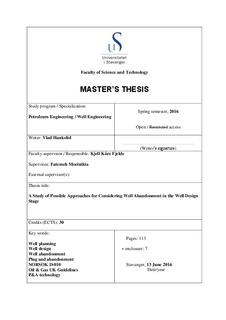| dc.contributor.author | Haukelid, Vlad | |
| dc.date.accessioned | 2016-09-19T12:22:34Z | |
| dc.date.available | 2016-09-19T12:22:34Z | |
| dc.date.issued | 2016-06-13 | |
| dc.identifier.uri | http://hdl.handle.net/11250/2408328 | |
| dc.description | Master's thesis in Petroleum engineering | nb_NO |
| dc.description.abstract | There are many fields on Norwegian Continental Shelf (NCS) that approach end of their design life. Based on feasibility studies, life of some fields is prolonged while it is shortened for others.
Since early days there was strong focus on drilling wells faster. Safety aspect came some time later. Little or no attention at all was given for future well abandonment activities. During the last decades, a lot of experience has been gained by operator companies when it comes to permanently plugging both old and ‘newly’ designed wells on NCS. Some old wells were abandoned in the manner of days while others required extensive resources to abandon. The common challenges were ranging from lack of basic well data to well design and subsurface conditions that were unfavourable for well abandonment, hence requiring additional efforts.
Well abandonment does not generate direct revenue neither for operator companies nor for society. This activity rather represents a huge cost, which should be minimised. In recent years authorities has started to emphasize the importance of considering well abandonment in well design stage and urged industry to cooperate and share the experience in order to find the best and cost efficient solutions for well abandonment.
This thesis is aiming to find and highlight factors that are of importance for considering well abandonment in well design stage. To do so, literature study was conducted which was later on supplemented with feedback from the industry through a questionnaire.
Several important factors have been identified and general recommendations have been outlined.
One of conclusions of the study is that not many adjustments to well design are necessary in order to facilitate future well abandonment when NORSOK Standard D-010 is followed.
Improvement potential of the Standard is also indicated. | nb_NO |
| dc.language.iso | eng | nb_NO |
| dc.publisher | University of Stavanger, Norway | nb_NO |
| dc.relation.ispartofseries | Masteroppgave/UIS-TN-IPT/2016; | |
| dc.rights | Navngivelse 3.0 Norge | * |
| dc.rights.uri | http://creativecommons.org/licenses/by/3.0/no/ | * |
| dc.subject | petroleumsteknologi | nb_NO |
| dc.subject | petroleum engineering | nb_NO |
| dc.subject | NORSOK D-010 | nb_NO |
| dc.subject | Oil & Gas UK Guidelines | nb_NO |
| dc.subject | P&A technology | nb_NO |
| dc.subject | well planning | nb_NO |
| dc.subject | well design | nb_NO |
| dc.subject | well abandonment | nb_NO |
| dc.subject | plug and abandonment | nb_NO |
| dc.subject | brønnteknologi | nb_NO |
| dc.title | A Study of Possible Approaches for Considering Well Abandonment in the Well Design Stage | nb_NO |
| dc.type | Master thesis | nb_NO |
| dc.subject.nsi | VDP::Technology: 500::Rock and petroleum disciplines: 510::Petroleum engineering: 512 | nb_NO |

